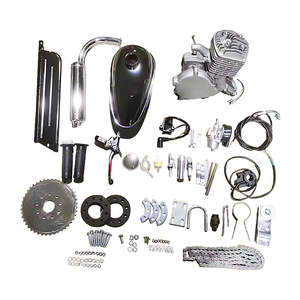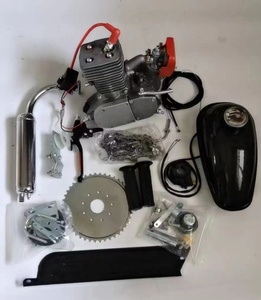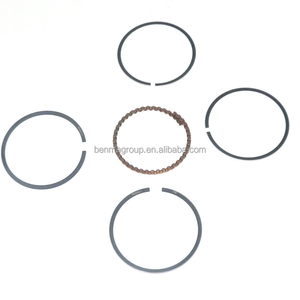(1229 products available)




























































































































































































Engine 60cc refers to any engine with a 60 cubic centimeter (cc) displacement. The cc measures the size of the engine. A higher cc means a larger engine size. A 60cc engine is suitable for small tasks, such as powering small vehicles, chainsaws, and other small machinery. 60cc engines are also used in two-stroke and four-stroke engine designs. Here are the types:
Two-Stroke 60cc Engine:
The two-stroke 60cc engine has a simple design. It consists of a few moving parts, such as a piston, cylinder, and crankshaft. The piston goes up and down in the cylinder. When the piston moves up, it draws in air and fuel through the inlet port. When the piston moves down, it compresses the air-fuel mixture. The spark plug ignites the compressed mixture, causing an explosion that pushes the piston back down. The two-stroke 60cc engine uses fuel efficiently. It produces a high power-to-weight ratio. However, it has high emissions and is not suitable for large tasks.
Four-Stroke 60cc Engine:
The four-stroke 60cc engine uses a four-step process to convert fuel into energy. The steps are the intake, compression, power, and exhaust strokes. During the intake stroke, the piston moves down and creates a vacuum in the cylinder. The crankshaft rotates and opens the inlet and exhaust valves to allow air and fuel into the cylinder. The crankshaft rotates during the compression and power strokes to close the valves. The piston moves up in the cylinder and compresses the air-fuel mixture. The spark plug ignites the mixture and creates energy that pushes the piston down. The exhaust stroke occurs when the crankshaft rotates and the piston moves up to expel the exhaust gases through the open exhaust valve. The four-stroke 60cc engine produces low emissions and noise. It also requires less maintenance because it lubricates the engine using oil. However, the four-stroke 60cc engine has a complex design. It also has a low power-to-weight ratio and is not suitable for high-speed tasks.
These are the specifications and maintenance tips for the engine 60cc as discussed below.
Engine Size
The 60cc engines are measured by the volume of the cylinders, which is 0.06 liters or 60cc. This is a small engine size that is commonly used for small and lightweight applications, such as lawn mowers, chainsaws, and other handheld equipment.
Power Output
The 60cc engines produce around 2 to 4 horsepower (1.5 to 3 kW) depending on the design and configuration. This power output is suitable for small and lightweight applications that require minimal power.
Torque
The torque output of 60cc engines is usually low, ranging from 2 to 3 lb-ft (2.7 to 4.1 Nm). This torque output is sufficient for small applications that require quick acceleration and deceleration.
Fuel Efficiency
The 60cc engines are designed to be fuel-efficient, with a fuel consumption rate of 50 to 100 miles per gallon (23 to 47 km/l). This fuel efficiency is important for applications that require frequent use and long operating hours.
Emissions
The 60cc engines produce low emissions, including carbon monoxide, hydrocarbons, and nitrogen oxides. These emissions are regulated by various agencies to ensure compliance with environmental standards.
Cooling System
The 60cc engines have a cooling system that helps dissipate heat generated during operation. The cooling system can be either air or water-based, depending on the engine design.
Starting System
The 60cc engines have a starting system that allows for easy and reliable starting. The starting system can be manual or electric, depending on the application and engine design.
Maintenance Schedule
Follow the manufacturer's recommended maintenance schedule for engine 60cc. This typically includes regular oil changes, air filter replacements, spark plug inspections, and other routine maintenance tasks.
Oil Changes
Regularly check the engine oil level and top up as needed. Change the engine oil and oil filter according to the recommended maintenance schedule or more frequently if the engine is operated under severe conditions (e.g., high load, extreme temperatures).
Air Filter Maintenance
Inspect the air filter regularly and clean or replace it if necessary. A clean air filter ensures proper airflow to the engine, maximizing performance and fuel efficiency.
Fuel System Maintenance
Use fresh, clean fuel as recommended by the manufacturer. Avoid using stale fuel or fuel with additives not suited for the engine. Clean the fuel filter regularly to ensure proper fuel delivery to the engine.
Cooling System Maintenance
If the engine has a cooling system (e.g., water-cooled), check the coolant level regularly and top up as needed. Flush and replace the coolant according to the manufacturer's recommendations for optimal cooling performance.
Ignition System Maintenance
Inspect the spark plug regularly for wear or deposits. Clean or replace the spark plug as needed to ensure proper ignition and combustion in the engine. Check the ignition timing and adjust it if necessary to maintain engine performance.
Mechanical Inspections
Regularly inspect the engine's mechanical components, such as the valves, pistons, and cylinders, for wear or damage. Perform necessary adjustments, repairs, or replacements to maintain optimal engine performance and reliability.
Electrical System Maintenance
If the engine has an electric starting system, check the battery regularly for charge and condition. Clean the battery terminals and connections to prevent corrosion and ensure reliable starting.
Choosing the right 60cc engine requires considering several factors:
Application:
Consider where and how the engine will be used. Different applications such as lawn care, construction, or chainsaw use may have different requirements in terms of power, torque, and emissions.
Power Requirements:
Determine the power requirements for the specific tasks or operations expected from the engine. Consider the type of workload, frequency of use, and performance expectations.
Brand and Quality:
Choose a reputable brand known for its quality and reliability. Well-established brands often provide engines with consistent performance and durability, reducing the risk of engine-related issues.
Maintenance and Serviceability:
Consider the ease of maintenance and availability of service support for the chosen engine. Select an engine that is easy to maintain, with readily available spare parts and accessible service centers if needed.
Noise and Vibration:
Consider the noise and vibration levels produced by the engine. Depending on the application, low noise and vibration may be important for operator comfort and compliance with environmental regulations.
Emissions and Environmental Considerations:
Take into account the emissions produced by the engine and its environmental impact. Select engines that comply with local emissions standards and regulations, and consider engines with lower emissions for environmentally friendly operations.
Price:
Consider the engine's initial purchase cost and the long-term operational costs, including fuel, maintenance, and spare parts. Strike a balance between price and performance, reliability, and efficiency to meet specific needs.
Many 60cc engines power small vehicles, like scooters and mopeds. Hence, maintaining and replacing the parts of these small engines is very important. Here is a step-by-step guide on how to replace the engine:
Step 1: Preparation
Find a clean and open area to work in. Make sure the new engine is the same as the old one. Get the right tools needed for the job. Read the manual to know how to remove the old engine and put in the new one.
Step 2: Remove the Old Engine
Turn off the engine and let it cool down. Unplug all wires and remove any parts that are connected to the engine, like the air filter and exhaust. Use the tools to take out the bolts holding the engine in place. Carefully lift the engine out of the vehicle.
Step 3: Install the New Engine
Put the new engine where the old one was. Use the tools to tighten the bolts and hold it in place. Connect all the wires, exhaust, and other parts like the air filter. Make sure everything is put on correctly.
Step 4: Final Checks
Check that the engine is working well. Look for any leaks or loose parts. Make sure the vehicle is running smoothly before driving it.
Q1: How fast is a 60 cc engine?
A1: The speed of a 60cc engine depends on several factors, including the type of vehicle or equipment it's used in, the gearing system, and overall design. Typically, a 60cc engine can reach speeds of 30 to 40 mph.
Q2: Is a 60 cc engine good?
A2: Whether a 60cc engine is good or not depends on the intended use. For small scooters and mopeds, it's adequate for city commuting. However, for high-speed needs or carrying heavy loads, a 60cc engine may be underpowered.
Q3: How much power does a 60 cc engine have?
A3: A 60cc engine generates around 2 to 4 horsepower. The power output may vary based on engine design and efficiency.
Q4: How many liters is a 60 cc engine?
A4: A 60cc engine is 0.060 liters or 60,000 cubic centimeters. It refers to the engine's displacement, which is the volume of air and fuel mixture in the engine's cylinders.
The web search volume for the keyword "engine 60cc" in the Vehicle Parts & Accessories category has shown a consistent average monthly web search volume of 10. Over the past year, there has been no significant change in web search volume, with both the three-month and one-year changes registering at 0%. The data over the last 12 months reveals a pattern of alternating months with 10 web searches and months with no web searches at all.
Analyzing the detailed trend for "engine 60cc," we observe that the web search volume peaks in December, July, and November, each showing 10 web searches, while all other months recorded zero web searches. This pattern suggests a cyclical interest in this specific engine size, possibly linked to seasonal trends in vehicle maintenance or purchases. The absence of web searches in intervening months indicates a highly sporadic interest, which could be influenced by specific market events or consumer behavior patterns.
The consistent zero percent change over the year and the three-month period suggests stability in the search demand, with no emerging trends or shifts in consumer interest. This stability, combined with the observed peaks, could indicate that "engine 60cc" is a niche keyword, attracting web searches only during specific periods, likely tied to seasonal activities or market availability of related vehicle parts and accessories.